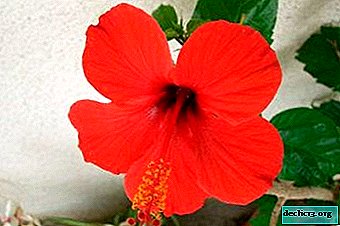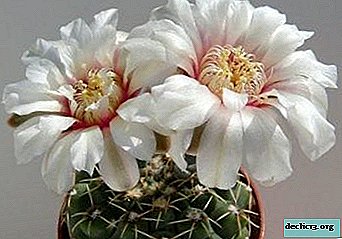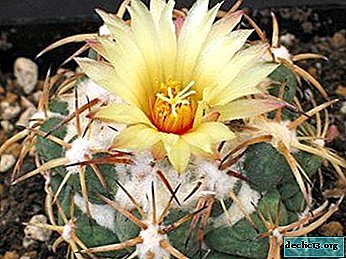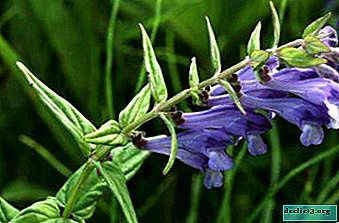Spectacular Chinese rose - photos, description of varieties, nuances of growing
 The popularity of the Chinese rose or hibiscus (this is one and the same) is incredibly high, and all thanks to its huge bright colors. It grows very quickly, it is easy to care for it, we can say that it is just the perfect plant to decorate any home and office. The great popularity of this plant is evidenced by the fact that its image is even on coins; in Malaysia, the Chinese rose is one of the symbols of the country. Consider what kind of flower it is, how to plant and grow a rose from China at home.
The popularity of the Chinese rose or hibiscus (this is one and the same) is incredibly high, and all thanks to its huge bright colors. It grows very quickly, it is easy to care for it, we can say that it is just the perfect plant to decorate any home and office. The great popularity of this plant is evidenced by the fact that its image is even on coins; in Malaysia, the Chinese rose is one of the symbols of the country. Consider what kind of flower it is, how to plant and grow a rose from China at home.
What it is?
- Brief biological description - There are more than 250 species of this plant; its scientific name is Hibiscus, it belongs to the family of the Malvaceae; large perennial shrub with large flowers of various colors.
- Detailed description of appearance - a shrub up to 2 meters high, with dark green shiny leaves, petiolate leaves, alternate, single, axillary flowers, the shape of the flower resembles a funnel, anthers protrude far outward, the flowers can be simple or double, smooth or velvety; flowering can last year round; shoot bark of a dark, often brown color.
- Plant passport - in natural conditions grows up to 4 m in the form of a bush or tree; prefers the tropics and subtropics.
- Country of origin - India and China.
What is the name and where did the name come from?
Hibiscus got its name - "Chinese rose" due to the fact that the flower itself (especially its terry forms) really looks like a large spectacular rose, and "Chinese" is just its country of origin.
What are hibiscus-like plants?
There are several types of flowers in nature, similar to the Chinese rose, these are:
- bush begonia - tropical beauty, very magnificent blooms with huge flowers;
- terry adenium - an amazing tree, not very tall (originally from Africa), with striking large bright flowers resembling a rose;
- terry geranium - a wonderful perennial, ornamental indoor plant that can bloom for a long time, there are varieties with very large terry flowers of various colors.
How long is a lifetime and can it be extended?
On a note. The life span of the Chinese rose is quite long, it can grow almost 30 years.If you carry out proper care of the plant, cut it and shape it in a timely manner, then it will delight you for a long time. But 30 years is the limit, natural aging occurs, so you need to think about breeding your pet in advance.
Description of species and their photos
In the photo below, you can see how a home-grown Chinese rose, also called hibiscus, looks like. Hibiscus has a lot of species and varieties, but the most interesting of them can be distinguished.
Angel wings
Chinese rose Angel Wings - a delightful low bush (not higher than 30 cm), blooms very profusely, literally the whole is covered with white-pink flowers, at the same time almost 100 pieces blossom.

Musky
A large bush, reaches 1.5 m, has a pink bark, leaves are heart-shaped, blooms in large bright burgundy flowers.

King
This is a variety with large bright yellow flowers, terry flowers, their diameter is 15 - 17 cm.

Cooper
It stands out for its variegation, its leaves are white-green, the flowers are bright red, a very spectacular plant.

What colors are there?
This gorgeous flower has a wide variety of colors, there is a whole palette of “pure” colors: white, yellow, orange, pink, red, burgundy, purple and some others. Chinese rose may have double-colored flowers - for example, the flower is red at the base, and then the color changes to orange or white turns to pink. There are also flowers with contrasting dots on the main background or stripes.
How to choose upon purchase?
When choosing a plant in a store, you need to pay attention, first of all, to the state of the flower itself. It should not have any mechanical damage - broken twigs or torn leaves. Then we look through the bush, paying attention to the back of the leaves - are there any pests. You should not buy a weak plant with a thin stem, it can hurt, it is better to choose a stronger one.
Landing at home
- Choosing a landing method - There are several ways to plant this plant:
- By seeds is a simple way, in January, seeds are sown and kept under greenhouse conditions until emergence, in the 3-leaf phase they are dived and planted in separate containers (how to grow hibiscus from seeds at home can be found here).
- Cuttings - this method is even simpler; the cuttings obtained during spring pruning must be treated with any growth stimulant and put in water to make roots appear, or in a mixture of peat and sand, in this case it will be necessary to cover with a jar on top, approximately 3 weeks later roots will form and the plant can be planted in a pot, when planting it is necessary to pinch it.
- Soil preparation - a plant needs nutritious and well-drained soil, you can buy ready-made soil for flowering shrubs (or for roses), everything is already balanced there, or you can create a suitable substrate yourself - take in equal parts humus, pine soil, turf and leaf, as well sand, peat and charcoal.
- Pot selection - For a Chinese rose, a ceramic pot is considered an ideal pot, and when you have to plant a large bush, then in this case a wooden tub will be a wonderful option.
Important! Before planting, a new ceramic pot needs to be soaked for several hours in hot water.
- The landing procedure itself:
- take a prepared pot;
- pour a layer of drainage there (expanded clay), then a substrate (not to the top);
- put the bush in the middle of the pot and gently straighten the roots;
- then we fall asleep with soil, slightly tamping;
- Then you need to pour and spray with soft water.
Step-by-step instructions for growing and caring
Features at different times of the year
This plant actively grows and blooms almost all year round, but a dormant period, which should fall in winter time, will be useful for it. Therefore, winter care is characterized by a temperature of maintenance (it needs to be reduced to 18 degrees), the frequency of watering (less often watering), not to make any top dressing at this time.
Learn about the features of caring for a Chinese rose at home, as well as see the photo, here.
Conditions of detention
 For Chinese roses need high humidity, you need to regularly spray defended water, and next to it put some kind of vessel with water. The optimum temperature in the summer is in the range of 23 - 25 degrees, in winter, a cooler content is required - about 18 - 20 degrees (not lower than 15).
For Chinese roses need high humidity, you need to regularly spray defended water, and next to it put some kind of vessel with water. The optimum temperature in the summer is in the range of 23 - 25 degrees, in winter, a cooler content is required - about 18 - 20 degrees (not lower than 15).
The plant needs bright lighting, but it must be scattered, direct rays will harm, so the choice of place for the flower needs to be done given this moment, respectively, the eastern and western windows will be a good place. In the warm season, the Chinese rose can be taken out into the fresh air - a terrace or balcony, it is very useful for her.
Watering
The flower does not tolerate moisture deficiency, so watering during the period of activity should be plentiful (only 3 cm of the top soil layer should dry), and during the dormant period, of course, it is reduced.
Top dressing
The best complex fertilizers for our plants are considered "Rainbow" and "Ideal", you need to make them 1 time in 2 weeks and only after watering so that the roots do not get burns.
Pruning
It is better to carry it out in early spring, while the buds have not yet begun to form, you need to cut off all the bare and elongated shoots, as well as good healthy twigs by about a third.
Recommendation. Also, during the summer, young shoots should be pinched for better bush formation.You will learn about hibiscus pruning rules from the video:
Transfer
We will tell you how to transplant a Chinese rose from pot to pot at home. Since the Chinese rose is growing very fast, then transplantation to a young plant is necessary every year, and an adult needs to be transplanted once every 4 years in the spring. If the bush grows in your tub, then you can simply replace the topsoil with a new one and that's it.
- When transplanting the pot, you need to take a little larger in size from the previous one, pour expanded clay or small pebbles on the bottom (the drainage layer can be a quarter of the volume of the pot).
- Then we plant or reload the plant and add new soil to empty places, water it.
After some time, the water will be absorbed and the soil will settle, you will need to pour the right amount, spray the bush and put it in place. Further care as usual.
Bloom
 Under indoor conditions, the Chinese rose blooms most often in the summer and picks up a bit of autumn. Inflorescences are large, spectacular, bloom one day. Each new flower blooms at dawn and already fades in the evening at sunset. At the same time, only 20 such exotic flowers can bloom on one branch.
Under indoor conditions, the Chinese rose blooms most often in the summer and picks up a bit of autumn. Inflorescences are large, spectacular, bloom one day. Each new flower blooms at dawn and already fades in the evening at sunset. At the same time, only 20 such exotic flowers can bloom on one branch.
If your plant does not want to bloom for a long time, it means that it does not have a dormant period, that is, when there was a period for laying buds (temperature should be 18 degrees) - it was most likely hot. Watering at this time (February - March) should be reduced and bright light is not needed at all. If all the rules are followed, then flowering is guaranteed.
Breeding
The flower propagates easily, the most convenient ways are cuttings and seeds.
- Cuttings - take them during spring pruning or in June cut from the apical parts of the shoots. You can wait for the roots by putting the cuttings in water, or you can put them in loose soil in greenhouse conditions (both options are good), after about a month you will have ready seedlings.
- Seeds - sow in January - February in loose soil, place in a greenhouse and maintain the desired humidity and temperature (for how to grow hibiscus from seeds at home, read here). Shoots appear quickly, as soon as they grow up a little - you can transplant in pots.
Read more about how to propagate a Chinese rose at home, read in our material.
Watch the video on how to cut hibiscus:
Diseases and Pests
Naturally, like all plants, problems also occur in the Chinese rose.
Attention! A plant due to improper care can become sick: leaves turn yellow (due to hard watering), buds crumble (temperature is low or there is little light), leaves become sluggish and drooping (insufficient watering).Insect pests can also greatly damage the plant:
- Spider mite - this is the main pest for the flower, it quickly appears when the plant does not have enough moisture in the air, and begins to braid all its leaves with its spider web, therefore it is recommended to regularly put the flower under a warm shower (only on the leaves), this is a good preventive measure against the tick; if detected, thoroughly wash the bush with soap and water; if a very severe defeat, then handle the “Actara”.
- Aphid - He also “loves” young leaves and buds of the Chinese rose, small sticky clumps appear on the leaves, the leaves can stick together, the aphid spreads quickly, so if it is detected, it is urgent to take measures, wash the bush with soap and water and treat with any insecticide.
- Thrips - an indicator of their presence: a grayish coating with brown dots appears on the leaves and they begin to curl; you need to immediately isolate the flower, then rinse the entire bush, try to remove the pest with cotton buds (clean off), then treat with an insecticide.
Read more about the causes of Chinese rose disease, diagnosis and their treatment, read in our material.
Disease prevention
In order to prevent diseases and attacks of insect pests, you just need to provide proper care and the necessary conditions. If there is good lighting, proper watering, enough humid air, top dressing will be applied in a timely manner, the plant will be trimmed and shaped, the correct pot and soil will be picked up, then no diseases and pests will be scary.
Conclusion
What can be summed up - of course, such a plant with unrealistically fabulous flowers needs to be settled in your home. Of course, it will become the central flower in any collection, not only due to its size, but also to its beauty. So also, the Chinese rose is capable of its energy to develop the creative potential of the owners of the house, to saturate with positive and joy.

















